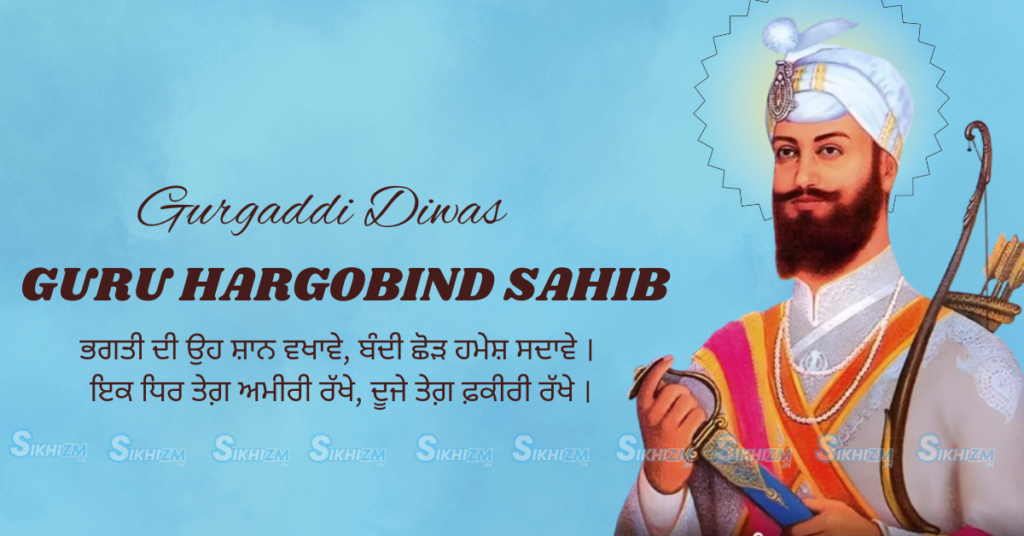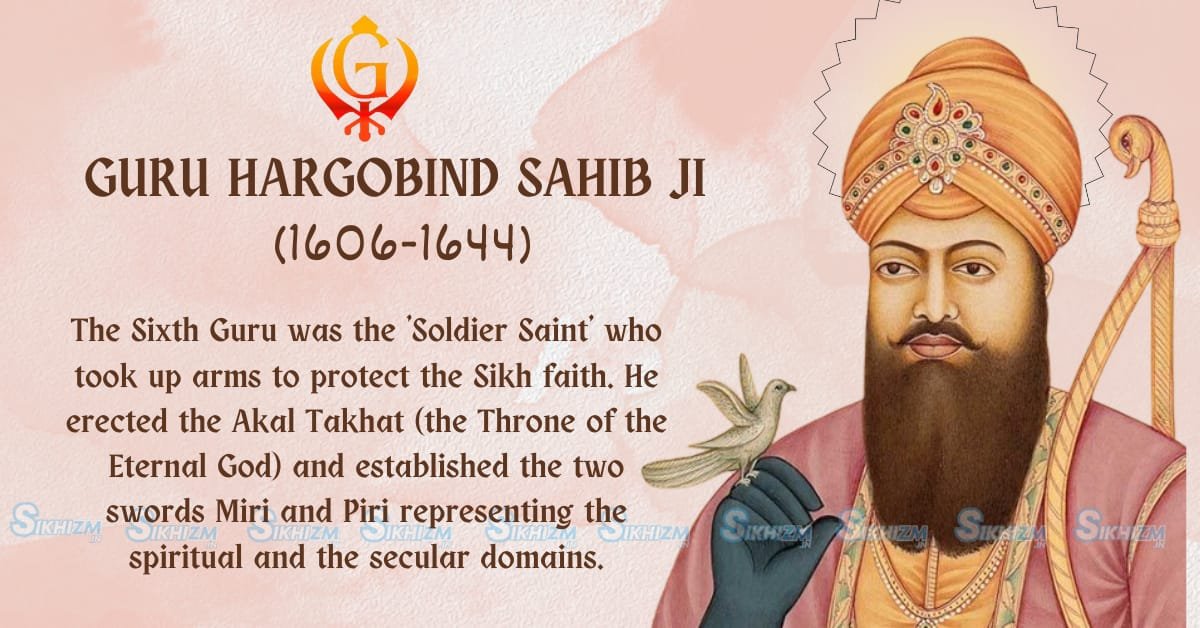Sikh Guru

Table of Contents
Guru Hargobind Sahib Ji
Guru Hargobind Sahib Ji (Gurmukhi: ਗੁਰੂ ਹਰਿਗੋਬਿੰਦ ਸਾਹਿਬ ਜੀ) was at village Guru Ki Wadali (district Amritsar) on Harh Vadi 7th (21 Harh), Samvat 1652 (19th June, 1595). Guru Hargobind Sahib Ji was the son of Sri Guru Arjan Dev Ji, the fifth guru in Sikh religion. His mother’s name was Mata Ganga Ji. He became Guru on 11th June 1606 following in the footsteps of his father Guru Arjan Dev Ji.
Guru Hargobind Sahib Ji had three wife’s named Mata Damodari Ji, Mata Marvahi Ji and Mata Nanaki Ji. Baba Gurditta Ji and Bibi Veero Ji were born from Mata Damodari Ji, Baba Suraj Mal Ji and Baba Ani Rai Ji was born from Mata Marvahi Ji and Baba Atal Rai Ji, and Guru Tegh Bahadur Ji were born from Mata Nanaki Ji.
Guru Ji’s Birth
Guru Hargobind Sahib Ji’s parents, Guru Arjan Dev Ji and Mata Ganga Ji did not have a child for a long time after their marriage. Guru Ji advised her to go in humility and seek for the blessings herself went meeting a Saint. The next day, Mata Ganga Ji prepared Missi Roti, churned butter and prepared buttermilk with her own hands. Mata Ji packed the food along with some onions. Mata Ji carried the meal on her head and walked barefoot for miles and went to see Baba Buddha Ji. Seeing Mata Ji today, Baba Buddha Ji was pleased. Baba Buddha Ji took the onion and smashed it in half with their hand and blessed Mata Ji with a gift of a son.
Know Some Unheard Things About Sri Guru Amardas Ji ||
Childhood
At the birth of Guru Hargobind Sahib Ji, Guru Arjan Dev Ji recited the following Shabad, calling it a gift from Guru Nanak Dev Ji.
ਗੁਰੁ ਨਾਨਕੁ ਤੁਠਾ ਕੀਨੀ ਦਾਤਿ ॥੪॥੭॥੧੦੧॥
Guru Nanak, greatly pleased, has bestowed this gift. ||4||7||101
Successor as Guru
After the Mughal Emperor Jahangir executed his father, Guru Arjan Dev, he was inspired to become a Guru at the young age of eleven. He studied religious texts with Bhai Gurdas and was inclined towards the hymns sung at Harmandir Sahib at an early age. His father Guru Arjan Dev five days before his death instructed his son Hargobind to start a military tradition to protect the Sikh people. He advised his son to surround himself with armed Sikhs for his safety. Later, Guru Arjan Dev was arrested by the Mughal emperor Jahangir. He was tortured and killed on the orders of Jahangir. Before his death, Guru Arjan Dev declared Hargobind as his successor. Baba Budda trained him in fencing and archery.
ਦਲਿ ਭੰਜਨ ਗੁਰੁ ਸੂਰਮਾ ਵਡ ਜੋਧਾ ਬਹੁ ਪਰਉਪਕਾਰੀ।
This Guru, the vanquisher of armies, is very brave and benevolent.
Start of Sikh Army
Guru Hargobind Sahib Ji was trained in horse riding as well. He had a good knowledge of astronomy, medicine and religious philosophy. Guru Hargobind Ji put two swords, one on his left side and one on his right side. The two swords were named Miri and Piri. Miri represented temporal power and Piri represented spiritual power. The purpose of keeping the Miri was to strike the opponent and Piri was to protect the innocent people. As per his father’s instructions, Guru Hargobind Sahib Ji founded an army of fifty- two men as number fifty- two was special in his life.

As per his father Arjan Dev’s advice, he always kept himself surrounded by armed men. Guru Hargobind Sahib Ji himself was trained in self-defence techniques. So, he always insisted people be physically fit to fight with their enemies. The torture of his father at the hands of Mughal emperor Jehangir prompted Guru Hargobind Sahib Ji to give a military direction to the Sikh community. He founded the first Sikh army named Akal Sena. Setting up an army was an answer against the escalating tortures of the Mughals. He emphasized the importance of horses and the army for the protection of the Sikhs against the oppression and injustice of the Mughals.
Download Our Latest App Amrit Kirtan Pothi ||
Akal Takht
In 5 Harh 1663 B ie. 1609 AD, Guru Hargobind Sahib Ji built Akal Takht (God’s throne) in front of Harmandir Sahib a hall dedicated to spiritual and temporal matters related to Sikh community. He built a fort named Lohgarh near Amritsar. Sangat gathered daily at Akal Takht where poets and Dhadis instilled bravery and patriotism among the Sikh warriors. Akal means timeless and Takhat means throne in Persian. Guru Ji built the map of the building along with Bhai Gurdas Ji and Baba Buddha Ji. The Akal Takht was the first Takht in the history of the Sikhs. According to Cunningham: “The genial disposition of the martial apostle led him to rejoice in the companionship of a camp, in the dangers of war, and in the excitements of the chase”.
Bandi Chhor Divas
As time passed, the influence of Guruji’s Eminence started spreading. The Mughals began to fear that Guruji was creating trouble for them. At that time the Mughal king Jahangir did not want to kill Guruji. If they had killed Guruji then the Sikhs would have been in anger. he asked Guru Ji to pay a fine and said Guru Arjan Dev Ji owed it. Guru Ji declined to pay this unjust fee and he got Guru ji imprisoned in Gwalior jail. Guru Ji was detained in the fort of Gwalior from 1609 to 1612. During that time some Hindu Kings were found in the caves near Guruji. Who was captured by the Mughals. Guru Ji used to decorate the diwan twice a day inside the fort. Hundreds of Sikh groups used to stand outside the fort to have the darshan of Guruji. Among those Mughals, a Muslim had feelings of love for the Guru. His name was Sant Meeya Meer. He asked the Jahangir to leave Guruji. Jahangir was satisfied with the words of Saint Meeya Meer and ordered to leave Guru Ji. Guru Ji refused to leave until He told me that I would leave here only when 52 Hindu kings would also be free along with me. After a lot of thinking, Jahangir told Guru Ji that whoever could catch the string of your clothes could go, that is why Guru Ji got clothes made with 52 strings and in this way by catching one string each, 52 Hindu kings got freedom from how. Bhai Gurdas Ji writes in his vaaran that the true Guru is a liberator, saying:
ਸਤਿਗੁਰੁ ਬੰਦੀਛੋੜੁ ਹੈ ਜੀਵਣ ਮੁਕਤਿ ਕਰੈ ਓਡੀਣਾ।
The true Guru is giver of freedom from bondages and makes the detached ones librated in life.
After this, Guru Ji started being known as “Bandi Chhor” or the one who gives freedom to the prisoners. Baba Buddha ji heard this news and the whole Amritsar was illuminated with light. That is why Sikhs celebrate “Bandi Chhor” day.

Passing the Gurgaddi
Guru ji established a city named Sri Hargobindpur. Guru ji established an education centre in Kiratpur Sahib. Guru ji spent the last moment of his life in Kiratpur Sahib. As soon as the time for attaining salvation came near, Guru ji handed over his Gurupad to his grandson Shri Har Rai ji.
Know Some Unheard Things About Sri Guru Nanak Dev Ji ||
Contribution to Sikhism
Guru Hargobind’s life was for the welfare of the Sikh community. He insisted Sikhs get trained in self-defence techniques and use them as a defence mechanism against opponents, especially the Mughals. He bolstered masses to get trained in weapons to protect themselves. He carried two swords though in Sikhism only one sword is carried. He named the two swords as Miri and Piri. Guru Hargobind tried to balance the spiritual and temporal authorities by carrying two swords. So, he started the concept of Miri and Piri. He was the first guru to engage in warfare battles against the Mughals. He fought four battles against the Mughals and won. His purpose in setting up Akal Takht was to grant justice and inculcate patriotism among the Sikhs. Gurudwaras set up by Guru Hargobind Sahib Ji hold spiritual and historical importance. Akal Takht was the first one in the history of Sikhism. When Guru Hargobind was imprisoned in Gwalior’s fort, he prayed for the ill emperor Jehangir. When Jehangir ordered to set Guru Hargobind Sahib Ji free, he demanded the release of 52 imprisoned Hindu kings. Jehangir released all 52 Hindu kings. That day is celebrated as Bandi Chori Diwas in Sikh history as the release of Guru Hargobind from the prison. Sikhs celebrate Diwali as Guru Hargobind returns to the holy city, Amritsar. Guru Hargobind gave a new direction to Sikhism. He taught selfless service, community service, charitable deeds, justice, empowerment and use of defence against oppression.
ਵਾਹਿਗੁਰੂ ਜੀ ਕਾ ਖਾਲਸਾ !!
ਵਾਹਿਗੁਰੂ ਜੀ ਕੀ ਫਤਹਿ !!

🙏🙏